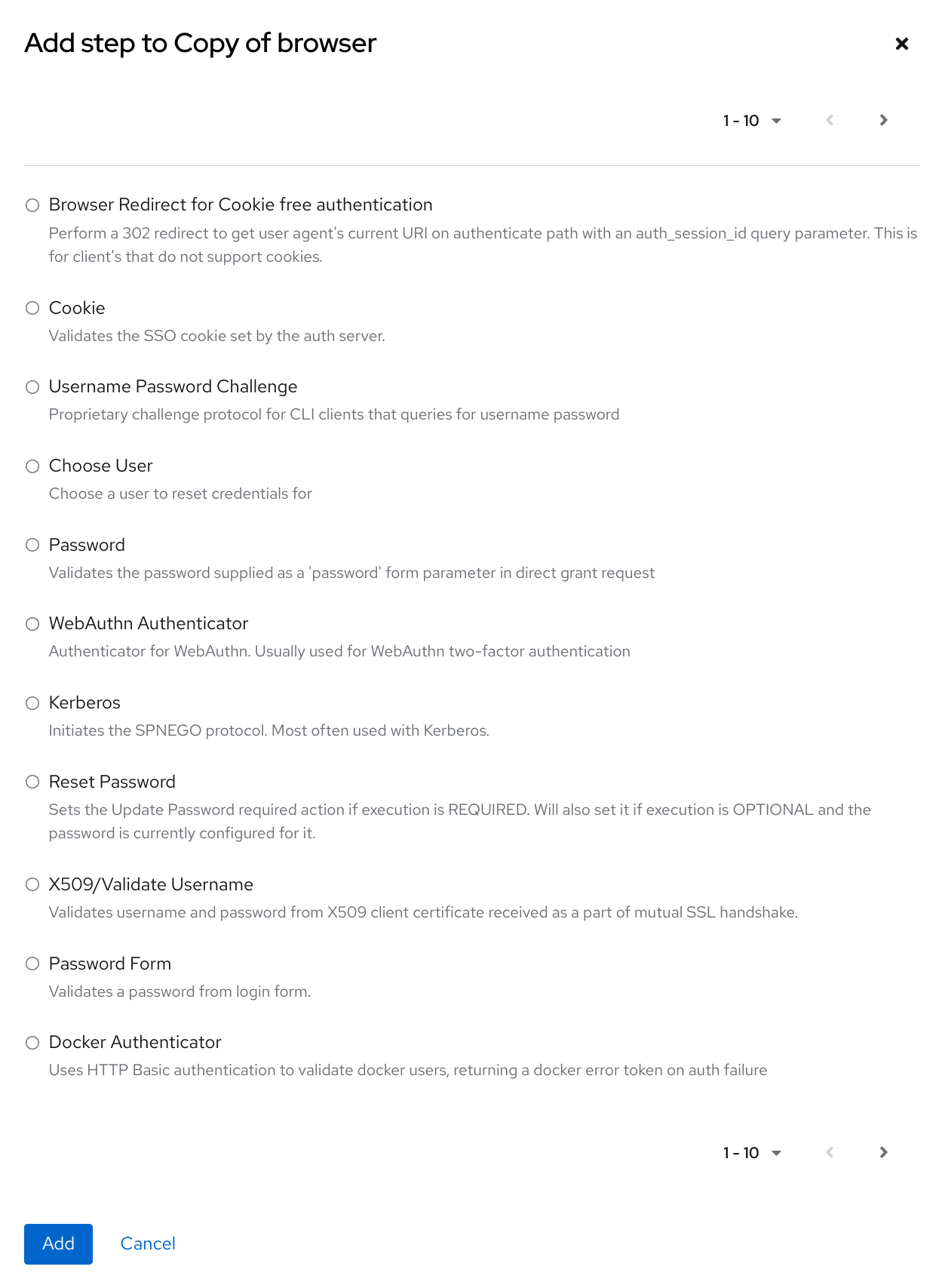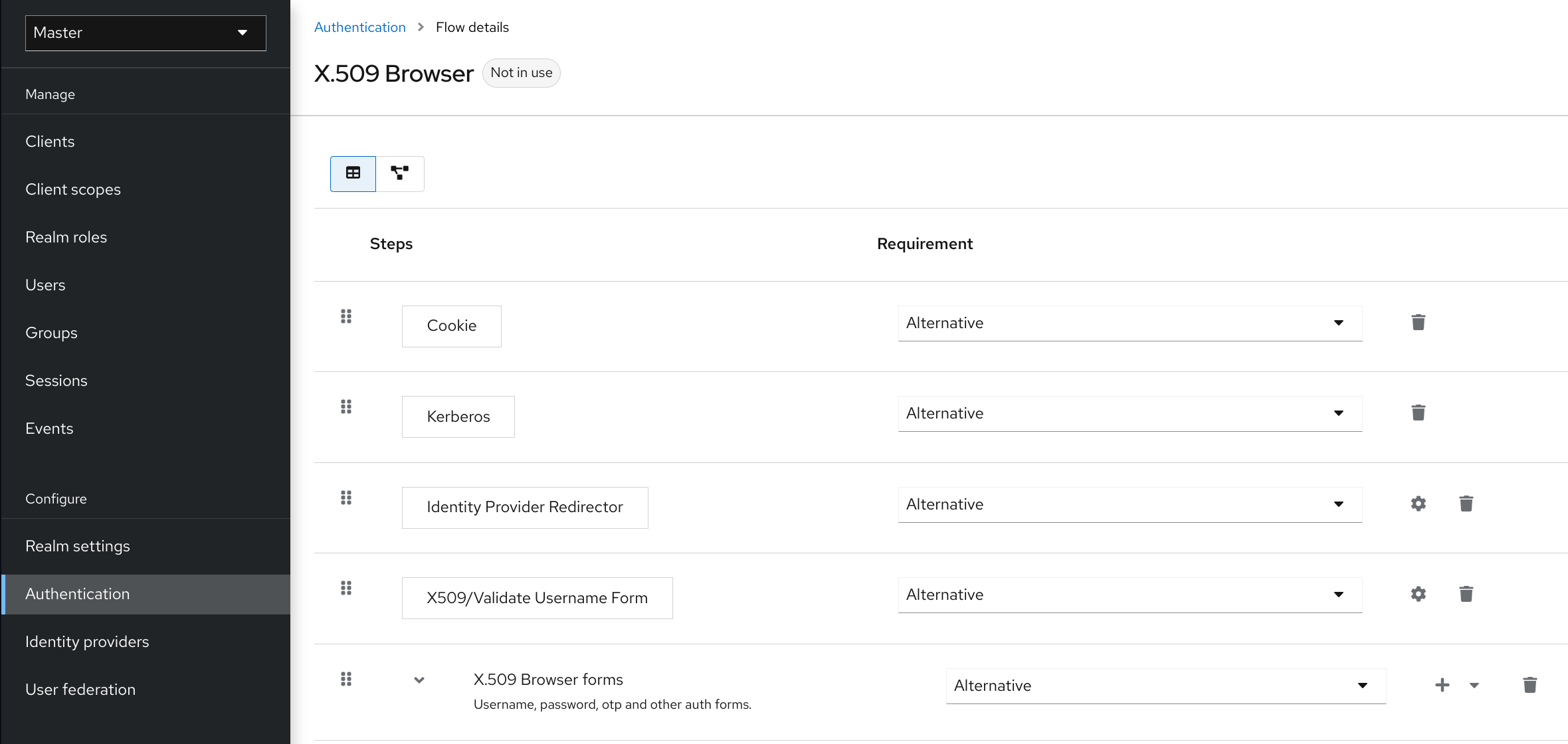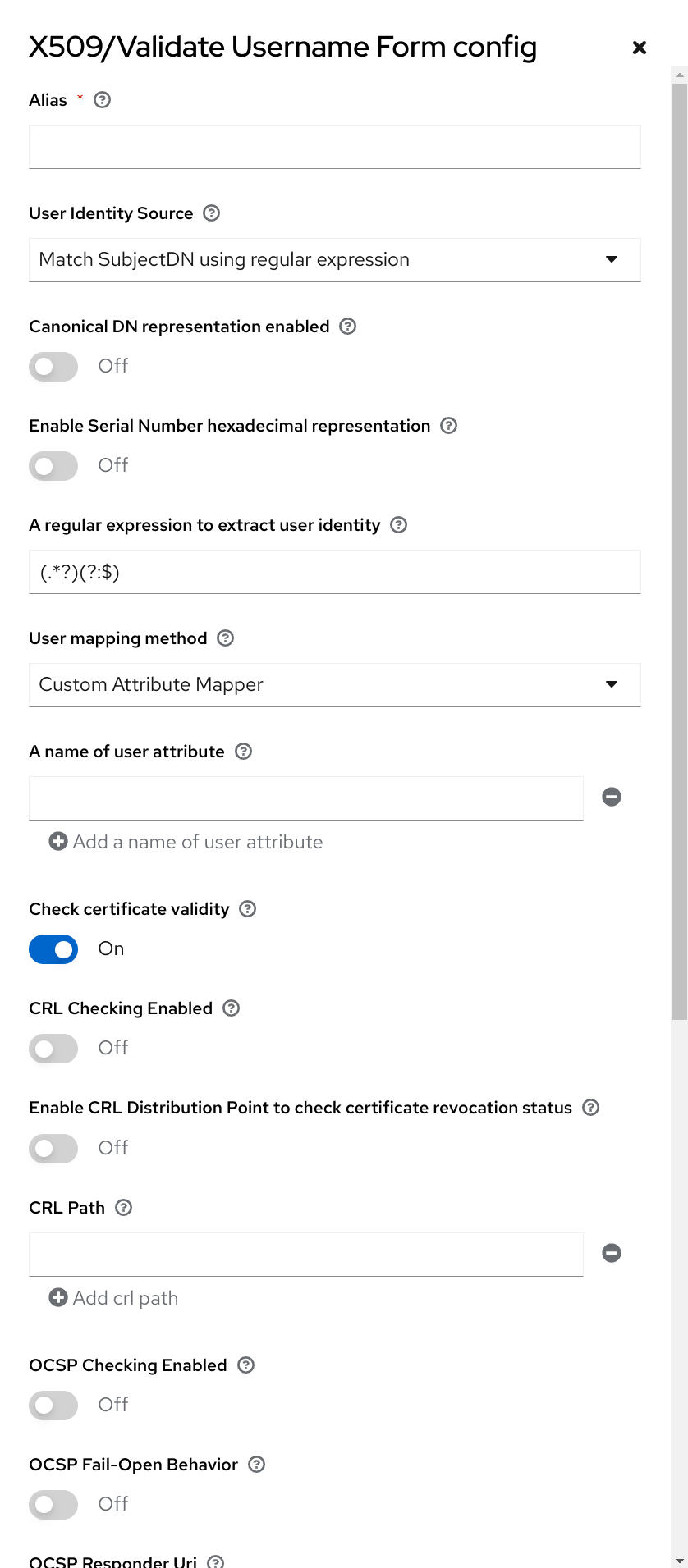X.509 client certificate user authentication
Keycloak supports logging in with an X.509 client certificate if you have configured the server to use mutual SSL authentication.
A typical workflow:
-
A client sends an authentication request over SSL/TLS channel.
-
During the SSL/TLS handshake, the server and the client exchange their x.509/v3 certificates.
-
The container (WildFly) validates the certificate PKIX path and the certificate expiration date.
-
The x.509 client certificate authenticator validates the client certificate by using the following methods:
-
Checks the certificate revocation status by using CRL or CRL Distribution Points.
-
Checks the Certificate revocation status by using OCSP (Online Certificate Status Protocol).
-
Validates whether the key in the certificate matches the expected key.
-
Validates whether the extended key in the certificate matches the expected extended key.
-
-
If any of the these checks fail, the x.509 authentication fails. Otherwise, the authenticator extracts the certificate identity and maps it to an existing user.
When the certificate maps to an existing user, the behavior diverges depending on the authentication flow:
-
In the Browser Flow, the server prompts users to confirm their identity or sign in with a username and password.
-
In the Direct Grant Flow, the server signs in the user.
| Note that it is the responsibility of the web container to validate certificate PKIX path. X.509 authenticator on the Keycloak side provides just the additional support for check the certificate expiration, certificate revocation status and key usage. If you are using Keycloak deployed behind reverse proxy, make sure that your reverse proxy is configured to validate PKIX path. If you do not use reverse proxy and users directly access the WildFly, you should be fine as WildFly makes sure that PKIX path is validated as long as it is configured as described below. |
Features
Supported Certificate Identity Sources:
-
Match SubjectDN by using regular expressions
-
X500 Subject’s email attribute
-
X500 Subject’s email from Subject Alternative Name Extension (RFC822Name General Name)
-
X500 Subject’s other name from Subject Alternative Name Extension. This other name is the User Principal Name (UPN), typically.
-
X500 Subject’s Common Name attribute
-
Match IssuerDN by using regular expressions
-
Certificate Serial Number
-
Certificate Serial Number and IssuerDN
-
SHA-256 Certificate thumbprint
-
Full certificate in PEM format
Regular expressions
Keycloak extracts the certificate identity from Subject DN or Issuer DN by using a regular expression as a filter. For example, this regular expression matches the email attribute:
emailAddress=(.*?)(?:,|$)The regular expression filtering applies if the Identity Source is set to either Match SubjectDN using regular expression or Match IssuerDN using regular expression.
Mapping certificate identity to an existing user
The certificate identity mapping can map the extracted user identity to an existing user’s username, email, or a custom attribute whose value matches the certificate identity. For example, setting Identity source to Subject’s email or User mapping method to Username or email makes the X.509 client certificate authenticator use the email attribute in the certificate’s Subject DN as the search criteria when searching for an existing user by username or by email.
|
Adding X.509 client certificate authentication to browser flows
-
Click Authentication in the menu.
-
Click the Browser flow.
-
From the Action list, select Duplicate.
-
Enter a name for the copy.
-
Click Duplicate.
-
Click Add step.
-
Click "X509/Validate Username Form".
-
Click Add.
X509 execution
-
Click and dragthe "X509/Validate Username Form" over the "Browser Forms" execution.
-
Set the requirement to "ALTERNATIVE".
X509 browser flow
-
Click the Action menu.
-
Click the Bind flow.
-
Click the Browser flow from the drop-down list.
-
Click Save.
X509 browser flow bindings
Configuring X.509 client certificate authentication

- User Identity Source
-
Defines the method for extracting the user identity from a client certificate.
- Canonical DN representation enabled
-
Defines whether to use canonical format to determine a distinguished name. The official Java API documentation describes the format. This option affects the two User Identity Sources Match SubjectDN using regular expression and Match IssuerDN using regular expression only. Enable this option when you set up a new Keycloak instance. Disable this option to retain backward compatibility with existing Keycloak instances.
- Enable Serial Number hexadecimal representation
-
Represent the serial number as hexadecimal. The serial number with the sign bit set to 1 must be left padded with 00 octet. For example, a serial number with decimal value 161, or a1 in hexadecimal representation is encoded as 00a1, according to RFC5280. See RFC5280, appendix-B for more details.
- A regular expression
-
A regular expression to use as a filter for extracting the certificate identity. The expression must contain a single group.
- User Mapping Method
-
Defines the method to match the certificate identity with an existing user. Username or email searches for existing users by username or email. Custom Attribute Mapper searches for existing users with a custom attribute that matches the certificate identity. The name of the custom attribute is configurable.
- A name of user attribute
-
A custom attribute whose value matches against the certificate identity. Use multiple custom attributes when attribute mapping is related to multiple values, For example, 'Certificate Serial Number and IssuerDN'.
- CRL Checking Enabled
-
Check the revocation status of the certificate by using the Certificate Revocation List. The location of the list is defined in the CRL file path attribute.
- Enable CRL Distribution Point to check certificate revocation status
-
Use CDP to check the certificate revocation status. Most PKI authorities include CDP in their certificates.
- CRL file path
-
The path to a file containing a CRL list. The value must be a path to a valid file if the CRL Checking Enabled option is enabled.
- OCSP Checking Enabled
-
Checks the certificate revocation status by using Online Certificate Status Protocol.
- OCSP Fail-Open Behavior
-
By default the OCSP check must return a positive response in order to continue with a successful authentication. Sometimes however this check can be inconclusive: for example, the OCSP server could be unreachable, overloaded, or the client certificate may not contain an OCSP responder URI. When this setting is turned ON, authentication will be denied only if an explicit negative response is received by the OCSP responder and the certificate is definitely revoked. If a valid OCSP response is not avalaible the authentication attempt will be accepted.
- OCSP Responder URI
-
Override the value of the OCSP responder URI in the certificate.
- Validate Key Usage
-
Verifies the certificate’s KeyUsage extension bits are set. For example, "digitalSignature,KeyEncipherment" verifies if bits 0 and 2 in the KeyUsage extension are set. Leave this parameter empty to disable the Key Usage validation. See RFC5280, Section-4.2.1.3 for more information. Keycloak raises an error when a key usage mismatch occurs.
- Validate Extended Key Usage
-
Verifies one or more purposes defined in the Extended Key Usage extension. See RFC5280, Section-4.2.1.12 for more information. Leave this parameter empty to disable the Extended Key Usage validation. Keycloak raises an error when flagged as critical by the issuing CA and a key usage extension mismatch occurs.
- Validate Certificate Policy
-
Verifies one or more policy OIDs as defined in the Certificate Policy extension. See RFC5280, Section-4.2.1.4. Leave the parameter empty to disable the Certificate Policy validation. Multiple policies should be separated using a comma.
- Certificate Policy Validation Mode
-
When more than one policy is specified in the
Validate Certificate Policysetting, it decides whether the matching should check for all requested policies to be present, or one match is enough for a successful authentication. Default value isAll, meaning that all requested policies should be present in the client certificate. - Bypass identity confirmation
-
If enabled, X.509 client certificate authentication does not prompt the user to confirm the certificate identity. Keycloak signs in the user upon successful authentication.
- Revalidate client certificate
-
If set, the client certificate trust chain will be always verified at the application level using the certificates present in the configured trust store. This can be useful if the underlying web server does not enforce client certificate chain validation, for example because it is behind a non-validating load balancer or reverse proxy, or when the number of allowed CAs is too large for the mutual SSL negotiation (most browsers cap the maximum SSL negotiation packet size at 32767 bytes, which corresponds to about 200 advertised CAs). By default this option is off.
Adding X.509 Client Certificate Authentication to a Direct Grant Flow
-
Click Authentication in the menu.
-
Select Duplicate from the "Action list" to make a copy of the built-in "Direct grant" flow.
-
Enter a name for the copy.
-
Click Duplicate.
-
Click the created flow.
-
Click the trash can icon 🗑️ of the "Username Validation" and click Delete.
-
Click the trash can icon 🗑️ of the "Password" and click Delete.
-
Click Add step.
-
Click "X509/Validate Username".
-
Click Add.
X509 direct grant execution
-
Set up the x509 authentication configuration by following the steps described in the x509 Browser Flow section.
-
Click the Bindings tab.
-
Click the Direct Grant Flow drop-down list.
-
Click the newly created "x509 Direct Grant" flow.
-
Click Save.
X509 direct grant flow bindings